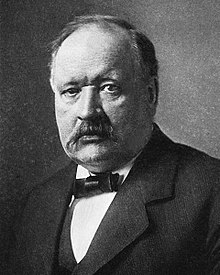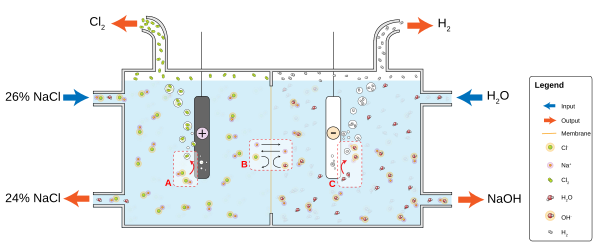Electrolyte
An electrolyte is a medium containing
Electrically, such a solution is neutral. If an
In medicine,
In science, electrolytes are one of the main components of electrochemical cells.[2]
In clinical
Etymology
The word electrolyte derives from Ancient Greek ήλεκτρο- (ēlectro-), prefix related to electricity, and λυτός (lytos), meaning "able to be untied or loosened".[7]
History

In his 1884 dissertation, Svante Arrhenius put forth his explanation of solid crystalline salts disassociating into paired charged particles when dissolved, for which he won the 1903 Nobel Prize in Chemistry.[8][9][10][11] Arrhenius's explanation was that in forming a solution, the salt dissociates into charged particles, to which Michael Faraday (1791-1867) had given the name "ions" many years earlier. Faraday's belief had been that ions were produced in the process of electrolysis. Arrhenius proposed that, even in the absence of an electric current, solutions of salts contained ions. He thus proposed that chemical reactions in solution were reactions between ions.[9][10][11]
Shortly after Arrhenius's hypothesis of ions, Franz Hofmeister and Siegmund Lewith[12][13][14] found that different ion types displayed different effects on such things as the solubility of proteins. A consistent ordering of these different ions on the magnitude of their effect arises consistently in many other systems as well. This has since become known as the Hofmeister series.
While the origins of these effects are not abundantly clear and have been debated throughout the past century, it has been suggested that the charge density of these ions is important[15] and might actually have explanations originating from the work of Charles-Augustin de Coulomb over 200 years ago.
Formation
Electrolyte solutions are normally formed when salt is placed into a
- NaCl(s) → Na+(aq) + Cl−(aq)
It is also possible for substances to react with water, producing ions. For example,
Molten salts can also be electrolytes as, for example, when sodium chloride is molten, the liquid conducts electricity. In particular, ionic liquids, which are molten salts with melting points below 100 °C,[16] are a type of highly conductive non-aqueous electrolytes and thus have found more and more applications in fuel cells and batteries.[17]
An electrolyte in a solution may be described as "concentrated" if it has a high concentration of ions, or "dilute" if it has a low concentration. If a high proportion of the solute dissociates to form free ions, the electrolyte is strong; if most of the solute does not dissociate, the electrolyte is weak. The properties of electrolytes may be exploited using electrolysis to extract constituent elements and compounds contained within the solution.[citation needed]
Alkaline earth metals form hydroxides that are strong electrolytes with limited solubility in water, due to the strong attraction between their constituent ions. This limits their application to situations where high solubility is required.[18]
In 2021 researchers have found that electrolyte can "substantially facilitate electrochemical corrosion studies in less conductive media".[19]
Physiological importance
In
All known multicellular lifeforms require a subtle and complex electrolyte balance between the
Both muscle tissue and
Electrolyte balance is maintained by oral, or in emergencies, intravenous (IV) intake of electrolyte-containing substances, and is regulated by
Measurement
Measurement of electrolytes is a commonly performed diagnostic procedure, performed via
Rehydration
In
A home-made electrolyte drink can be made by using water, sugar and salt in precise proportions.[25] It is important to include glucose (sugar) to utilise the co-transport mechanism of sodium and glucose. Commercial preparations are also available[26] for both human and veterinary use.
Electrolytes are commonly found in
Electrochemistry
When electrodes are placed in an electrolyte and a voltage is applied, the electrolyte will conduct electricity. Lone electrons normally cannot pass through the electrolyte; instead, a chemical reaction occurs at the cathode, providing electrons to the electrolyte. Another reaction occurs at the anode, consuming electrons from the electrolyte. As a result, a negative charge cloud develops in the electrolyte around the cathode, and a positive charge develops around the anode. The ions in the electrolyte neutralize these charges, enabling the electrons to keep flowing and the reactions to continue.[citation needed]

For example, in a solution of ordinary table salt (sodium chloride, NaCl) in water, the cathode reaction will be
- 2 H2O + 2e− → 2 OH− + H2
and hydrogen gas will bubble up; the anode reaction is
- 2 NaCl → 2 Na+ + Cl2 + 2e−
and chlorine gas will be liberated into solution where it reacts with the sodium and hydroxyl ions to produce sodium hypochlorite - household bleach. The positively charged sodium ions Na+ will react toward the cathode, neutralizing the negative charge of OH− there, and the negatively charged hydroxide ions OH− will react toward the anode, neutralizing the positive charge of Na+ there. Without the ions from the electrolyte, the charges around the electrode would slow down continued electron flow; diffusion of H+ and OH− through water to the other electrode takes longer than movement of the much more prevalent salt ions. Electrolytes dissociate in water because water molecules are dipoles and the dipoles orient in an energetically favorable manner to solvate the ions.
In other systems, the electrode reactions can involve the metals of the electrodes as well as the ions of the electrolyte.
Electrolytic conductors are used in electronic devices where the chemical reaction at a metal-electrolyte interface yields useful effects.
- In batteries, two materials with different electron affinities are used as electrodes; electrons flow from one electrode to the other outside of the battery, while inside the battery the circuit is closed by the electrolyte's ions. Here, the electrode reactions convert chemical energy to electrical energy.[27]
- In some fuel cells, a solid electrolyte or proton conductor connects the plates electrically while keeping the hydrogen and oxygen fuel gases separated.[28]
- In electroplating tanks, the electrolyte simultaneously deposits metal onto the object to be plated, and electrically connects that object in the circuit.
- In operation-hours gauges, two thin columns of mercury are separated by a small electrolyte-filled gap, and, as charge is passed through the device, the metal dissolves on one side and plates out on the other, causing the visible gap to slowly move along.
- In insulatingcoating, while the electrolyte layer behaves as one capacitor plate.
- In some hygrometers the humidity of air is sensed by measuring the conductivity of a nearly dry electrolyte.
- Hot, softened glass is an electrolytic conductor, and some glass manufacturers keep the glass molten by passing a large current through it.
Solid electrolytes
Solid electrolytes can be mostly divided into four groups described below.
Gel electrolytes
Gel electrolytes – closely resemble liquid electrolytes. In essence, they are liquids in a flexible
Polymer electrolytes
Dry polymer electrolytes – differ from liquid and gel electrolytes in the sense that salt is dissolved directly into the solid medium. Usually it is a relatively high
Ceramic electrolytes
Solid ceramic electrolytes –
Organic plastic electrolytes
Organic ionic plastic crystals – are a type
See also
- Strong electrolyte
- Salt bridge
- ITIES (interface between two immiscible electrolyte solutions)
- Ion transport number
- Elektrolytdatenbank Regensburg
- VTPR
- Electrochemical machining
References
- from the original on 18 December 2021. Retrieved 18 December 2021.
- ^ OCLC 1202758685.
- ISBN 978-3-527-34200-6.
- PMID 29611710.
- ISBN 978-1-58255-923-0.
- ^ "electrolyte". National Cancer Institute. 2 February 2011. Archived from the original on 23 April 2018. Retrieved 18 December 2021.
- ^ "Electrolyte - Definition, List of Electrolytes and Examples with Videos". BYJUS. Archived from the original on 3 February 2023. Retrieved 10 July 2022.
- ^ "The Nobel Prize in Chemistry 1903". Archived from the original on 8 July 2018. Retrieved 5 January 2017.
- ^ ISBN 978-0-231035-729.
- ^ ISBN 978-085-229553-3.
- ^ ISBN 978-0-684101-125.
- ^ Franz Hofmeister (1888). "Zur Lehre Von Der Wirkung Der Salze". Naunyn-Schmiedeberg's Arch. Pharmacol.
- from the original on 20 January 2022. Retrieved 8 November 2021.
- PMID 35543205.
- S2CID 244578563.
- ISSN 0441-3776. Archived from the original(PDF) on 2 March 2017. Retrieved 1 March 2017.
- ^
Jiangshui Luo, Jin Hu, Wolfgang Saak, Rüdiger Beckhaus, Gunther Wittstock, Ivo F. J. Vankelecom, Carsten Agert, Olaf Conrad (2011). "Protic ionic liquid and ionic melts prepared from methanesulfonic acid and 1H-1,2,4-triazole as high temperature PEMFC electrolytes". S2CID 94400312.
- ^ Brown, Chemistry: The Central Science, 14th edition, pg. 680.
- S2CID 229508133.
- ^ PMID 32272658.
- ^ Ye S(, Tang Z( (1986). 细胞膜钠泵及其临床意义. 上海医学 [Shanghai Medicine] (in Simplified Chinese) (1): 1. Archived from the original on 3 March 2017. Retrieved 3 March 2017.
- ^ Tu Z( (2004). 电解质紊乱对晚期肿瘤的治疗影响. 中华中西医杂志 [Chinese Magazine of Chinese and Western Medicine] (in Simplified Chinese) (10). 张定昌.
在正常人体内,钠离子占细胞外液阳离子总量的92%,钾离子占细胞内液阳离子总量的98%左右。钠、钾离子的相对平衡,维持着整个细胞的功能和结构的完整。钠、钾是人体内最主要的电解质成分...
- ^ Open Resources for Nursing, Ernstmeyer K, Christman E (2021), "Chapter 15 Fluids and Electrolytes", Nursing Fundamentals [Internet], Chippewa Valley Technical College, retrieved 28 February 2024
- PMID 18347684.
- ^ "Rehydration drinks". Webmd.com. 28 April 2008. Archived from the original on 23 October 2008. Retrieved 25 December 2018.
- ^ "Oral Rehydration Salt Suppliers". Rehydrate.org. 7 October 2014. Archived from the original on 7 December 2014. Retrieved 4 December 2014.
- ^ .
- ^ a b c d
Jiangshui Luo, Annemette H. Jensen, Neil R. Brooks, Jeroen Sniekers, Martin Knipper, David Aili, Qingfeng Li, Bram Vanroy, Michael Wübbenhorst, Feng Yan, Luc Van Meervelt, Zhigang Shao, Jianhua Fang, Zheng-Hong Luo, Dirk E. De Vos, Koen Binnemans, Jan Fransaer (2015). "1,2,4-Triazolium perfluorobutanesulfonate as an archetypal pure protic organic ionic plastic crystal electrolyte for all-solid-state fuel cells". S2CID 84176511.
- ^ "The Roll-to-Roll Battery Revolution". Ev World. Archived from the original on 10 July 2011. Retrieved 20 August 2010.
- ISSN 0378-7753.
- ISSN 0013-4686.
- ISSN 0378-7753.
- ^
Jiangshui Luo, Olaf Conrad, Ivo F. J. Vankelecom (2013). "Imidazolium methanesulfonate as a high temperature proton conductor". S2CID 96622511.
External links
 Media related to Electrolytes at Wikimedia Commons
Media related to Electrolytes at Wikimedia Commons- Friedman HL (1960). "Mayer's Ionic Solution Theory Applied to Electrolyte Mixtures". The Journal of Chemical Physics. 32 (4): 1134–1149. .
- Leaist DG, Lyons PA (1981). "Multicomponent diffusion of electrolytes with incomplete dissociation. Diffusion in a buffer solution". The Journal of Physical Chemistry. 85 (12): 1756–1762. .
- Kaminsky M (1957). "Ion-solvent interaction and the viscosity of strong-electrolyte solutions". Discussions of the Faraday Society. 24: 171. .

